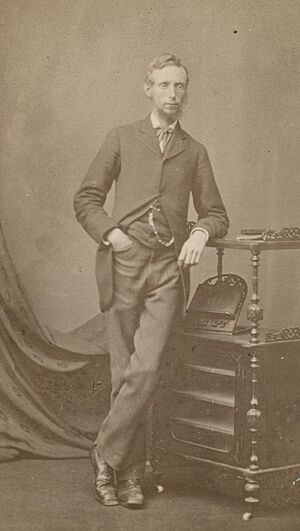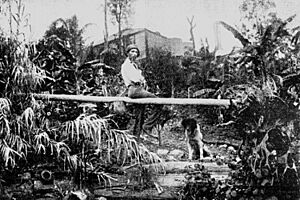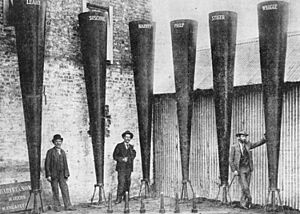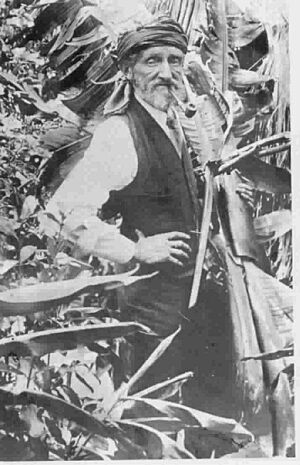Clement Lindley Wragge facts for kids
Quick facts for kids
Clement Wragge
|
|
|---|---|
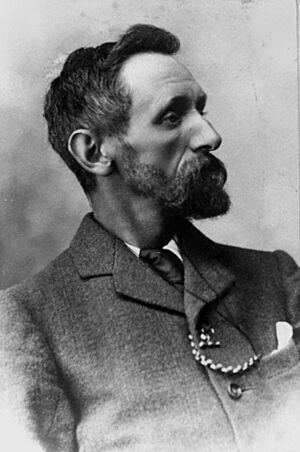
Clement Wragge, circa 1901
|
|
| Born | 18 September 1852 Stourbridge, Worcestershire, England
|
| Died | 10 December 1922 (aged 70) Auckland, New Zealand
|
| Nationality | British |
| Occupation | Meteorologist |
Clement Lindley Wragge (18 September 1852 – 10 December 1922) was a famous meteorologist. He was born in Stourbridge, England. As a child, he moved to Oakamoor, Staffordshire.
Wragge was a member of the Royal Geographical Society. He also joined the Royal Meteorological Society in London. He was very interested in different spiritual ideas throughout his life. He even met Mirza Ghulam Ahmad, who started the Ahmadiyya movement in Islam. Later, Sir Arthur Conan Doyle (who wrote the Sherlock Holmes books) visited Wragge in New Zealand to ask about his thoughts on spiritualism.
Clement Wragge first studied law. But he soon became a meteorologist. He won a Gold Medal from the Scottish Meteorological Society. He is also famous for starting the idea of using people's names for cyclones. He traveled a lot, giving talks in places like London and India. In his later years, he was an expert on the weather in Australia and the Pacific Islands.
Contents
Clement Wragge's Early Life and Adventures
Clement Wragge was originally named William. But his name was changed to Clement. Both of his parents died when he was very young. His grandmother, Emma Wragge, raised him for several years. She taught him about the sky and weather.
Clement loved nature from a young age. He explored the beautiful Churnet valley. He went to school in Oakamoor and then to Uttoxeter Grammar School. He didn't like being a boarder at Uttoxeter and even ran away once!
After his grandmother passed away, Clement moved to London. He lived with his aunt and her family. He continued his education and later studied law. He also traveled a lot in Europe with his uncle.
When he was 21, Clement received money from his parents. He decided to take a break from his law studies. He went on an eight-month trip to Egypt and the Middle East.
Exploring the World
In 1874, Clement and a friend started a big journey. They traveled from London to Paris and then sailed to Egypt. He explored the Nile River and even joined an archaeological dig. Next, he toured Palestine and Jerusalem. There, he met a group of Mormons. He promised to visit their new city in Salt Lake, USA.
Clement decided to keep traveling instead of going home. He sailed to Australia via India. From Australia, he crossed the Pacific Ocean to San Francisco. He then traveled by train across America to Toronto. In Salt Lake City, he briefly met Brigham Young, a leader of the Mormon faith. He later wrote articles about the Mormons. In Toronto, he met his cousin, Edmund Wragge, who became a famous railway engineer.
When he returned home, Clement decided law was not for him. He trained to be a midshipman. In 1876, he sailed to Melbourne, Australia, working on the ship. He was a good singer and enjoyed the sea songs.
In Australia, he worked for the Surveyor-General's Department. He helped survey land in South Australia. In 1877, he married Leonora Edith Florence d'Eresby Thornton. They returned to England in 1878.
Becoming a Meteorologist
Wragge wanted to learn more about weather. So, he set up two weather stations in Staffordshire, England. One was at a low level, and another was high up in the hills. He took readings every day from 1879 to 1883. He also wrote many articles for local newspapers and magazines.
In 1881, Clement heard about plans for a weather station on Ben Nevis in Scotland. Ben Nevis is the highest mountain in the UK. Wragge offered to climb the mountain daily to take weather readings. He did this from June to October. His wife took readings at sea level. For his hard work, Wragge won the Scottish Meteorological Society's Gold Medal.
A Summit Observatory was opened on Ben Nevis in 1883. Wragge applied to be the superintendent, but he didn't get the job. He had a growing family, and the job required long periods away from home.
Wragge and his wife had three children. Their first son, Clement Lionel Egerton, later joined the Australian army. Sadly, he died in 1915 during the Battle of Gallipoli.
Weather Forecasting in Australia
In 1883, Wragge decided to return to Australia. He brought his wife, his loyal dog Renzo, and his cat. In 1884, he set up a private weather observatory near Adelaide. He also created a weather station on Mount Lofty. In 1886, he helped start the Royal Meteorological Society of Australia.
His work impressed the Queensland Government. They asked him to write a report on how to set up a weather service. This service would help prevent ships from being lost in cyclones. The government was so impressed that they hired him! On January 1, 1887, he became the Government Meteorologist for Queensland.
Soon after he arrived, a huge amount of rain fell. This earned him the nickname "Inclement" Wragge. He built a home called Capemba in Taringa, Brisbane.
Wragge quickly became well-known. He started making weather charts and predictions for all of Australia, not just Queensland. This caused some disagreements with other meteorologists. He also pointed out that he and his team focused only on weather. Other weather experts had to do other government jobs too.
Naming Cyclones and Rainmaking
In the late 1800s, Wragge built many weather stations across Queensland. He also created a system of storm signals. These signals would be sent by telegraph to coastal towns. This helped warn ships about bad weather. He even set up an international service with New Caledonia to get weather data.
Wragge is famous for starting the idea of naming cyclones. At first, he thought about using letters from the Greek alphabet. But then he decided to use names from Polynesian myths. He also named cyclones after politicians, like James Drake and Alfred Deakin. Other fun names he used were Xerxes and Hannibal. After Wragge retired, the practice of naming cyclones stopped for 60 years.
In 1898, Wragge started publishing Wragge's Australian Weather Guide and Almanac. This book had weather information. It also included facts about geology, farming, and mining.
In 1902, there was a terrible drought. Wragge bought some special machines called Steiger Vortex Cannons. People thought these cannons could make rain from the clouds. They tried firing them in Charleville, but it didn't work. Today, two of these cannons are on display in Charleville.
Wragge left his job with the Queensland Government in 1903. This was because his funding was reduced after Australia became a federation.
Later Years and Legacy
After leaving his government job, Wragge traveled for several years. In 1904, he visited the Cook Islands, New Caledonia, and Tahiti. He studied local animals and wrote a report on caterpillars.
He tried to get a job as the Commonwealth Meteorologist in Australia in 1908, but he was not successful. He then moved to New Zealand. He settled in Auckland with Louisa Emmeline Horne, who shared his interest in spiritual ideas.
In Auckland, he started the Wragge Institute and Museum. Sadly, a fire later destroyed part of it, including many of his writings. He also created the beautiful Waiata tropical gardens.
During his trip to India in 1908, Wragge met Mirza Ghulam Ahmad. Some of Ghulam Ahmad's followers believe Wragge became a Muslim. However, his family records suggest he remained interested in spiritualism until he died.
Clement Wragge passed away on December 10, 1922, in Auckland. He had a stroke. His son, Kismet K Wragge, continued to work at the Wragge Institute.


